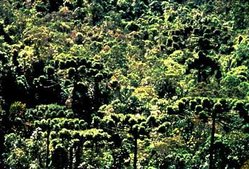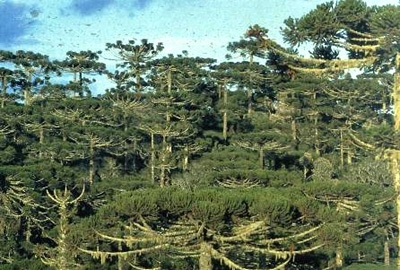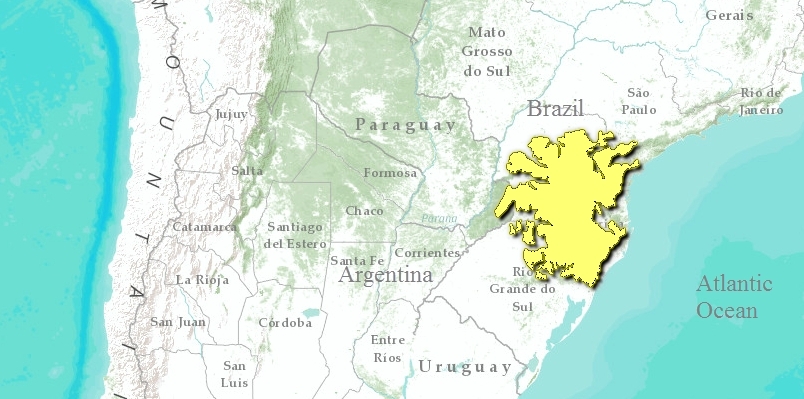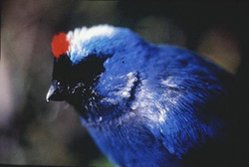Araucaria moist forests
 Araucaria, Brazil. (Photograph by WWF)
Araucaria, Brazil. (Photograph by WWF) This ecoregion spans the mountainous areas of southern Atlantic Brazil and extends into northeastern Argentina. These forests are a relict of a once widespread ecosystem of mixed coniferous and broad-leafed trees, spread out across a mountainous landscape. Forests spread from middle-level plateaus of around 500 meters (m) to the high slopes of the Serra da Mantiqueira, which rise to 1600 m above sea-level. The climate is subtropical with frequent frosts and without a dry season. Annual precipitation is high, and ranges from 1300-3000 millimeters (mm). These mixed forests are convergent with savanna regions to the south, cerrado scrub to the north, and moist forests to the east and west. Less than one percent of the ecoregion is covered by protected areas. More reserves are needed to save these biologically rich forest from illegal logging and urban expansion.
Location and General Description
Brazilian Araucaria moist forests are bordered on the north and west by Paraná-Paranaíba forests, on the south by the Pampas, and on the east by Serra do Mar moist forests. Most of this ecoregion is on sedimentary rocks of the Paraná Plateaus. The climate is subtropical with frequent frosts and with no dry season. Annual precipitation shows a significant variation between 1,300 mm and 3,000 mm. Soils throughout the ecoregion range from fertile latosols to impoverished lithosols. Forests are spread from middle-level plateaus, 500 m elevation, to the high slopes of Serra da Mantiqueira, 1,600 m elevation. The main vegetation is Atlantic moist forest, with a particular 45-meter-tall emergent strata of the Brazilian Araucaria (Araucaria angustifolia). Canopy layers are rich in species of Lauraceae (Ocotea pretiosa, O. catharinense), Myrtaceae (Campomanesia xanthocarpa), and Leguminosae (Parapiptadenia rigida). Although apparently homogeneous, Brazilian Araucaria moist forests vary a lot in both composition and structure. These forests form complex mosaics of plant associations among the pioneer Brazilian Araucaria and tree species from different types of Atlantic forest. This ecoregion also includes an interesting association of Brazilian Araucaria with grasslands. Because of its unique features of climate, geomorphology and floristic composition, Brazilian Araucaria moist forests are easily set apart from other portions of the Brazilian Atlantic forest.
Biodiversity Features
Brazilian Araucaria moist forests represent a extraordinary mosaic combining species from a relict coniferous forest (including several Andean genera) with Atlantic forest species. In this mosaic, several endemic species are found. Among 352 plant species recorded in this region, 47 (13.3 percent) are endemics. This moist forest ecoregion is recognized as an important Endemic Bird Area. It is also home for Atlantic endemic and threatened vertebrates such as the brown howler monkey (Alouatta fusca) and the red spectacled Amazon (Amazona petrei), which have few populations scattered in remnants of these forests. Other rare mammals include the Guianan squirrel (Sciurus aestuans), and Paca (Agouti paca). Threatened vascular plant species also survive here, including the Brazilian Araucaria. From a evolutionary perspective, Brazilian Araucaria moist forests represent more widespread South America coniferous forests of the past and, therefore, have great importance for conservation.
Current Status
These moist forests have been reduced in area by 87 percent. Remaining vegetation is represented by 35,045.67 km2 of mixed forests. Few large blocks of habitat are preserved by official protection. In addition, thousands of private 1- to 100-hectare remnants surrounded by pastures and agriculture represent a significant part of remaining vegetation. Protected areas cover only 0.62 percent of the ecoregion.
Types and Severity of Threats
Illegal timber extraction and forest conversion into agricultural lands represent a large threat to the future of these forests because they possess fertile soils that are attractive to agricultural interests.
Justification of Ecoregion Delineation
Brazilian Araucaria moist forests comprise a well delimited patch of Atlantic forest associated with coniferous species-a mixed forest. All botanical classifications rank such forests as a type of the Atlantic forest complex. The delineation’s for the Araucaria Moist Forests were derived by lumping vegetative coverage units of the IBGE map (1993) to trace the historic distribution of Brazilian Araucaria (Araucaria angustifolia) forests (Mata de Pinheiros). The following coverages were lumped: all Mata de Pinheiros classifications (montane ombrophilous mist forest, upper montane ombrophilous mist forest, and secondary vegetation), and within the broader perimeters of these forest types, all agricultural activities and savanna vegetation were lumped. Linework was then reviewed and modified by N. Vlarty and during a priority setting workshop. Linework extensions for limits of this ecoregion into Argentina were done by expert opinion from this workshop.
Additional information on this ecoregion
- For a shorter summary of this entry, see the WWF WildWorld profile of this ecoregion.
- To see the species that live in this ecoregion, including images and threat levels, see the WWF Wildfinder description of this ecoregion.
- World Wildlife Fund Homepage
Further Reading
- Experts workshop for ecoregional priority setting. 10-14 August, 1999, Atibaia, Sao Paulo, Brazil
- Fundação Instituto Brasilero de Geografia Estatística-IBGE. 1993. Mapa de vegetação do Brasil. Map 1:5,000,000. Rio de Janeiro, Brazil.
- HUECK, K. 1972. As florestas da América do Sul: ecologia, composição e importância econômica. Editora da Universidade de Brasília e Editora Polígono, São Paulo.
- KLEIN, R.M. 1960. O aspecto dinâmico do pinheiro brasileiro. Sellowia 12:17-44.
- KLEIN, R.M. 1990. Espécies raras ou ameaçadas de extinção: Estado de Santa Catarina. Vol 1. Myrtáceas e Bromeliáceas. IBGE, Rio de Janeiro.
- LEITE, P.F. & KLEIN, R. M. 1990. Vegetação. In: Mesquita, O. V. (ed.), Geografia do Brasil -- Região Sul, vol. 2. IBGE, Rio de Janeiro. pp. 113-150
- MENDES, S.L. 1999. Grupo mamíferos- documento preliminar. In: Conservation International (ed.). Workshop Avaliação e Ações Prioritárias para Conservação dos Biomas Floresta Atlântica e Campos Sulinos, São Paulo.
- RAMBO, B. 1951. O elemento Andino no Pinhal Riograndense. Anais Botânicos do Herbário Barbosa Rodrigues. 3:3-36.
- RIZZINI, C.T. 1997. Tratado de fitogeografia do Brasil. 2° ed. Editora Nova Fronteira, Rio de Janeiro.
- SILVA, J.M.C. & DINNOUTI, A. 1999. Análise de representatividade das unidades de conservação federais de uso indireto na Floresta Atlântica e Campos Sulinos. In: Conservation International (ed.). Workshop Avaliação e Ações Prioritárias para Conservação dos Biomas Floresta Atlântica e Campos Sulinos, São Paulo.
- SÃO PAULO. 1998. Fauna ameaçada no Estado de São Paulo. Secretaria do Meio Ambiente, Série PROBIO, São Paulo.
- SOS MATA ATLÂNTICA. 1998. Atlas da evolução dos remanescentes florestais e ecossistemas associados no domínio da Mata Atlântica no período 1990-1995. Fundação SOS Mata Atlântica, Instituto Socioambiental e Instituto de Pesquisas Espaciais, São Paulo.
- Veloso, H. P., Rangel-Filho, A.L.R. & LIMA, J.C.A. 1991. Classificação da vegetação brasileira adaptada a um sistema universal. IBGE, Rio de Janeiro.
- Vlarty, N. Personal communications. August, 1999.
- WEGE, D.C. & LONG, A. J. 1995. Key areas for threatened birds in the neotropics. BirdLife Conservation Series No. 5.
| Disclaimer: This article is taken wholly from, or contains information that was originally published by, the World Wildlife Fund. Topic editors and authors for the Encyclopedia of Earth may have edited its content or added new information. The use of information from the World Wildlife Fund should not be construed as support for or endorsement by that organization for any new information added by EoE personnel, or for any editing of the original content. |


